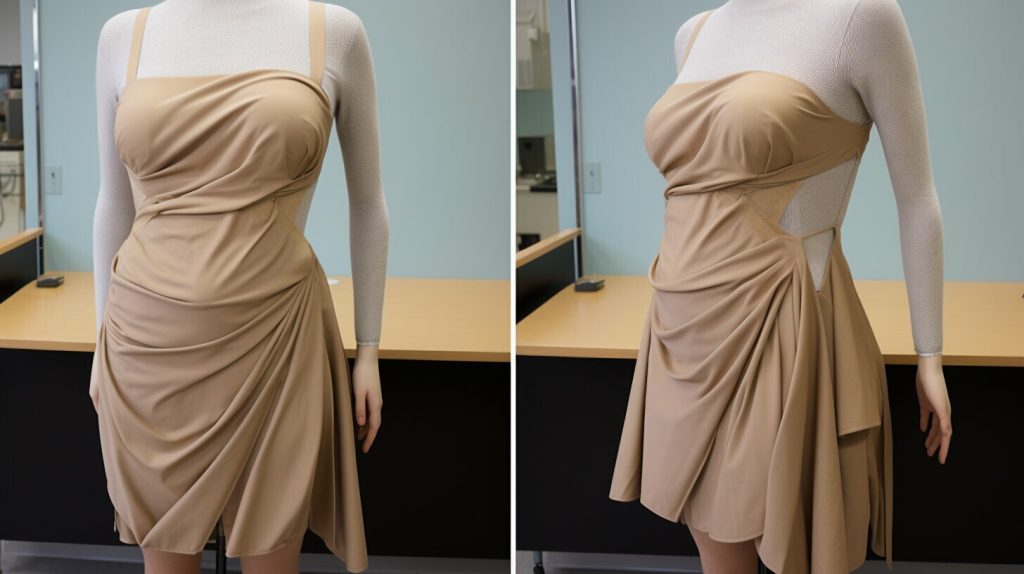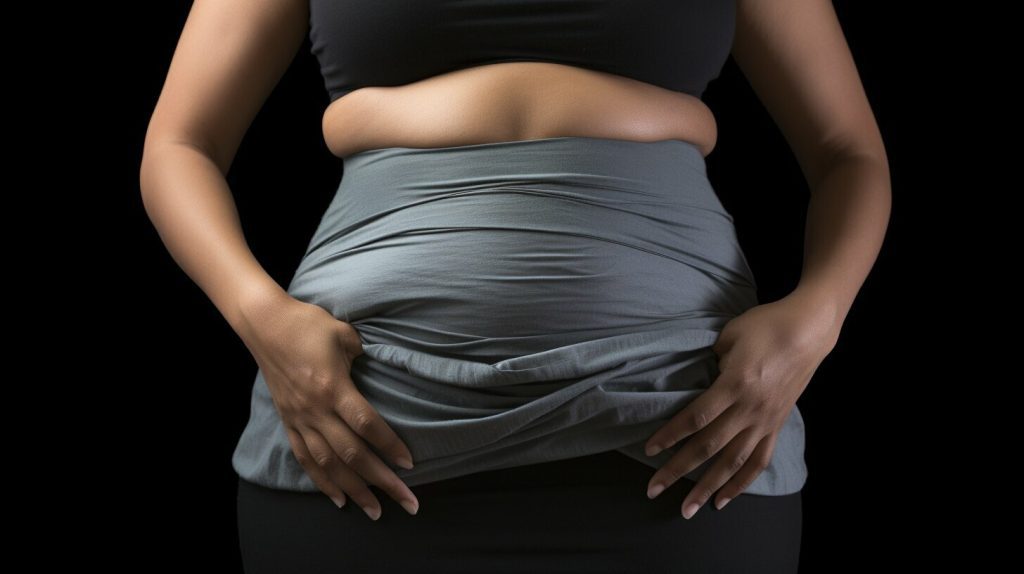An apron belly, also known as a panniculus or mother’s apron, is a mass of tissue that hangs down from the stomach, resembling an apron. It can occur in both men and women, resulting from factors such as pregnancy, significant weight gain, or rapid weight loss. A balanced diet, targeted exercises, and lifestyle modifications can help reduce or get rid of an apron belly without surgery. However, spot reduction or losing fat from one specific area is not possible, so a comprehensive approach that includes overall body fat reduction is recommended.
Key Takeaways:
- Apron belly is a mass of tissue that hangs down from the stomach, resembling an apron.
- It can occur in both men and women due to factors such as pregnancy, significant weight gain, or rapid weight loss.
- A balanced diet, targeted exercises, and lifestyle modifications can help reduce or eliminate an apron belly without surgery.
- Spot reduction is not possible, so an overall body fat reduction approach is recommended.
- Consulting with a healthcare professional is advised for personalized guidance and support.
What Causes an Apron Belly?
An apron belly can be caused by various factors, including pregnancy, weight gain, excess skin, men, and significant weight loss.
During pregnancy, the abdominal skin stretches, and fat cells expand, leading to the development of an apron-like flap of tissue. This is a natural response to accommodate the growing baby and can result in excess skin and fat in the abdominal area.
In some cases, both men and women may develop an apron belly due to significant weight gain. The excess weight can lead to the accumulation of fat in the abdominal region, resulting in the appearance of an apron-like belly. Similarly, individuals who have lost a significant amount of weight may experience an apron belly due to excess skin that remains after the weight loss.
Other potential causes of an apron belly include obesity and rapid weight loss. Obesity can contribute to the accumulation of excess fat in the abdominal area, while rapid weight loss can result in loose skin that hangs down, resembling an apron.

Table: Causes of an Apron Belly
| Cause | Description |
|---|---|
| Pregnancy | Stretching of the abdominal skin and fat accumulation during pregnancy |
| Weight Gain | Significant weight gain leading to fat accumulation in the abdominal area |
| Excess Skin | Excess skin left after weight loss or due to genetic factors |
| Men | Men can also develop an apron belly due to weight gain or excess skin |
| Significant Weight Loss | Rapid weight loss resulting in loose skin that hangs down |
Can You Reduce or Get Rid of an Apron Belly Without Surgery?
Many people wonder if it is possible to reduce or get rid of an apron belly without resorting to surgery. The good news is that with a combination of a balanced diet, targeted exercises, and lifestyle modifications, it is indeed possible to achieve a reduction in apron belly. It is important to note that spot reduction, or losing fat from one specific area, is not possible. Therefore, a comprehensive approach that focuses on overall body fat reduction is recommended for the best results.
A balanced diet plays a crucial role in reducing an apron belly. This includes consuming nutrient-dense foods and controlling portion sizes. Incorporating lean proteins, fruits, vegetables, and whole grains into your meals can support weight loss efforts. It is also important to reduce the consumption of processed foods and sugars, as they can contribute to fat accumulation in the abdominal area.
In addition to a balanced diet, targeted exercises can help strengthen the core muscles and contribute to reducing an apron belly. Incorporating exercises that focus on the abdominal muscles, such as planks, crunches, and leg raises, can help tone and tighten the area. Strength training exercises that work the entire body, such as squats and lunges, can also aid in overall fat reduction and improving body composition.
Lifestyle modifications are also essential in reducing an apron belly. Increasing physical activity levels through regular exercise, such as walking or swimming, can help burn calories and promote weight loss. Stress management techniques, such as meditation or deep-breathing exercises, can also be beneficial, as stress can contribute to weight gain and fat storage in the abdominal area. It is important to consult with a healthcare professional before starting any new diet or exercise regimen to ensure safety and suitability for individual needs.
| Approach | Description |
|---|---|
| Balanced Diet | Avoid processed foods and sugars. Include lean proteins, fruits, vegetables, and whole grains. |
| Targeted Exercises | Incorporate exercises that focus on the abdominal muscles and strength training exercises for overall fat reduction. |
| Lifestyle Modifications | Increase physical activity levels and practice stress management techniques. |
By following a balanced diet, incorporating targeted exercises, and making lifestyle modifications, individuals can reduce or even eliminate an apron belly without the need for surgery. However, it is important to note that individual results may vary, and it is always advisable to consult with a healthcare professional for personalized guidance and support.

Addressing an Apron Belly After Pregnancy
An apron belly that occurs after pregnancy, also known as a postpartum belly, is a natural response to the expansion and stretching of the skin and abdominal muscles during childbirth. To address an apron belly after pregnancy, it is important to engage in postpartum exercise, such as walking and pelvic floor exercises, as advised by a healthcare professional.
Gradually introducing more targeted exercises, such as postnatal yoga or pilates, can also be beneficial. These exercises help strengthen the core muscles and improve overall body tone. Postnatal yoga, in particular, focuses on gentle movements and stretches that target the abdomen, helping to tone and strengthen the muscles.
Breastfeeding, with the approval of a healthcare professional, may also aid in postpartum weight loss and shrinking the uterus. Additionally, wearing postpartum compression garments can provide comfort and support during the recovery period, helping to contour the abdominal area. These garments provide gentle compression, promoting proper healing and reducing swelling.

Suggested Postpartum Exercise Routine:
- Begin with gentle exercises, such as walking or light cardio, to gradually increase your activity level.
- Incorporate pelvic floor exercises, also known as Kegels, to strengthen the muscles that support the bladder, uterus, and rectum.
- Engage in postnatal yoga or pilates, focusing on movements that target the abdominal muscles and promote overall strength and flexibility.
- Consult with a healthcare professional or a certified postpartum fitness specialist to customize an exercise routine that suits your individual needs.
By following a consistent postpartum exercise routine and wearing postpartum compression garments, you can help address and reduce an apron belly after pregnancy. It is important to listen to your body and consult with a healthcare professional throughout the process to ensure a safe and effective recovery.
Dealing with an Apron Belly After Rapid Weight Loss
After experiencing rapid weight loss, individuals may find themselves dealing with an apron belly, which can be a challenge to address. However, there are several strategies that can help improve the appearance of an apron belly without resorting to surgical interventions.
Strength training: Incorporating strength training exercises into your fitness routine can be beneficial in building lean muscle mass. This can help fill out some of the loose skin caused by rapid weight loss and improve overall body composition. Focus on exercises that target the abdominal area, such as planks, crunches, and leg raises.
Hydration and nutrition: Maintaining proper hydration and nutrition is essential for skin health and elasticity. Drink plenty of water throughout the day to keep your skin hydrated, and consume a balanced diet rich in nutrients. Including foods high in collagen, such as bone broth, can also support skin elasticity.
Skin firming creams: While skin firming creams may not provide drastic results, they can contribute to improving skin elasticity over time. Look for creams that contain ingredients like retinol, hyaluronic acid, or collagen to support the firmness and tightness of the skin.
Non-surgical treatments: Various non-surgical treatments can help tighten and lift loose skin, reducing the appearance of an apron belly. These treatments include laser treatments, ultrasound, radiofrequency, and IPL (Intense Pulsed Light) treatments. It’s important to consult with a healthcare professional to determine the most suitable treatment option for your specific situation.

Table: Non-Surgical Treatment Options for Apron Belly
| Treatment Option | Description | Estimated Cost |
|---|---|---|
| Laser treatments | Uses laser technology to stimulate collagen production and tighten loose skin. | $500 – $2,500 per session |
| Ultrasound | Utilizes ultrasound waves to target and tighten the deeper layers of the skin. | $1,500 – $5,000 per session |
| Radiofrequency | Delivers radiofrequency energy to heat and tighten the skin. | $1,000 – $4,000 per session |
| IPL (Intense Pulsed Light) treatments | Uses intense pulsed light to stimulate collagen production and tighten loose skin. | $500 – $2,000 per session |
By incorporating strength training exercises, maintaining hydration and nutrition, considering skin firming creams, and exploring non-surgical treatment options, individuals can effectively deal with an apron belly after rapid weight loss. Remember that consulting with a healthcare professional is essential to determine the most appropriate approach for your specific needs and goals.
Health Consequences of Having Extra Belly Fat
Excess belly fat, especially visceral fat that surrounds the internal organs, can have significant health consequences. Studies have shown that individuals with excess belly fat are at a higher risk of developing heart disease, type 2 diabetes, certain cancers, and sleep apnea. Visceral fat in the abdominal area can promote inflammation and insulin resistance, leading to an increased likelihood of cardiovascular problems and metabolic disorders.
| Health Consequence | Description |
|---|---|
| Heart Disease | Excess belly fat is associated with elevated levels of triglycerides and LDL cholesterol, increased blood pressure, and reduced HDL cholesterol, all of which are risk factors for heart disease. |
| Type 2 Diabetes | Visceral fat produces hormones and other substances that can interfere with insulin’s ability to regulate blood sugar, leading to insulin resistance and an increased risk of developing type 2 diabetes. |
| Certain Cancers | Studies have found a link between excess belly fat and an increased risk of certain types of cancer, including breast and colorectal cancer. |
| Sleep Apnea | Excess belly fat can contribute to the narrowing or blockage of the airways during sleep, leading to sleep apnea, a condition characterized by disrupted breathing patterns and poor sleep quality. |
Reducing excess belly fat is not only important for aesthetic reasons but also for improving overall health and reducing the risk of these health consequences. Adopting a healthy lifestyle that includes regular exercise, a balanced diet, and stress management techniques can help individuals achieve a healthier weight and reduce excess belly fat.
Tips to Reduce and Avoid Apron Belly
To reduce and avoid an apron belly, adopting a physically active lifestyle is essential. Engaging in regular physical activity, such as walking, swimming, or dancing, can help burn calories, promote weight loss, and improve overall health. Aim for at least 150 minutes of moderate-intensity aerobic activity or 75 minutes of vigorous-intensity aerobic activity each week. Additionally, incorporating strength training exercises two or more days a week can help build lean muscle mass and boost metabolism.
A balanced diet plays a crucial role in reducing and preventing an apron belly. Focus on portion control and choose nutrient-rich foods that support weight loss. Incorporate ample amounts of fruits and vegetables, whole grains, and lean proteins into your meals. Fill your plate with colorful produce and opt for lean protein sources such as chicken, fish, beans, and tofu. Limit your intake of processed foods, sugary beverages, and high-fat foods as they can contribute to weight gain and abdominal fat accumulation.
Stress management is an often overlooked aspect of reducing an apron belly. Chronic stress can trigger the production of cortisol, a hormone that can promote fat storage, particularly in the abdominal area. Engage in stress-reducing activities such as yoga, meditation, deep breathing exercises, or hobbies that you enjoy. Prioritize self-care and establish a healthy work-life balance to help manage stress levels and support your weight loss efforts.
Tips to Reduce and Avoid Apron Belly:
- Engage in regular physical activity, including both aerobic exercises and strength training.
- Follow a balanced diet that emphasizes portion control, fruits, vegetables, and lean proteins.
- Avoid or limit processed foods, sugary beverages, and high-fat foods.
- Manage stress through activities such as yoga, meditation, or deep breathing exercises.
By incorporating these tips into your daily routine, you can take proactive steps towards reducing and avoiding an apron belly. Remember to consult with a healthcare professional for personalized guidance and support throughout your journey. With consistency and perseverance, you can achieve a healthier, more confident you.

Clothing Accessories and Tips for Hiding Apron Belly
When it comes to dressing to hide an apron belly, there are several tips and accessories that can help create a flattering and confident look. Whether you’re heading to a social event or want to feel more comfortable in your everyday attire, these suggestions can make a difference in how you feel and present yourself. Here are some dressing tips to consider:
1. Ruching Effect and Drapes
Choose tops with a ruching effect or drapes around the midsection. These details can create visual interest and distract the eye from the apron belly area. Look for tops that have ruching or draping along the sides or in the center, as these can help create a more balanced and slimming silhouette.
2. Opt for Loose-Fitting Tops
Loose-fitting tops that don’t cling to the body can be a great option for hiding an apron belly. Choose tops that have a slight A-line or flowy silhouette, as these can provide coverage and minimize the appearance of the belly area. Avoid tight-fitting tops that accentuate the apron belly instead of concealing it.
3. Pair with Leggings or High-Waisted Pants
When choosing bottoms, consider pairing your tops with leggings or high-waisted pants. Leggings can provide a comfortable and streamlined base, while high-waisted pants can help tuck in the tummy and create a more defined waistline. These options can be versatile and allow you to create different looks while still minimizing the focus on the apron belly.
4. Create Vertical Lines
Adding vertical lines to your outfit can help divert attention from the abdominal area. Consider layering your look with cardigans, jackets, or ponchos that create vertical lines down the body. This can help elongate the silhouette and take the focus away from the apron belly. Additionally, choosing tops or dresses with vertical patterns or stripes can also have a similar flattering effect.
5. Consider Shapewear
If you feel comfortable doing so, wearing shapewear can provide extra support and enhance your body shape. Look for high-waisted shapewear that can smooth out the midsection and create a more streamlined look under your clothes. Be sure to choose shapewear that fits well and doesn’t create discomfort.
Remember, dressing to hide an apron belly is all about finding what makes you feel confident and comfortable. Experiment with different styles, cuts, and accessories to discover what works best for you and your body type. Most importantly, embrace your unique beauty and rock your outfits with pride!

Conclusion
After understanding the causes and effects of an apron belly, it is clear that reducing or getting rid of it is possible with the right approach. Following a balanced diet, engaging in targeted exercises, and making lifestyle modifications can make a significant difference in reducing apron belly fat. However, it’s important to remember that spot reduction is not possible, and overall body fat reduction should be the goal.
Consulting with a healthcare professional throughout this journey can provide personalized guidance and support. They can help create a plan tailored to individual needs and ensure that the chosen methods are safe and effective. By taking steps to address an apron belly, individuals can not only boost their confidence but also improve their overall health and well-being.
Remember, the process of reducing an apron belly takes time and effort. It requires patience, consistency, and dedication. But with the right mindset and a comprehensive approach, you can achieve your goals and feel more comfortable in your own skin. Don’t hesitate to seek professional help and always prioritize your health along this journey.
FAQ
What is an apron belly?
An apron belly, also known as a panniculus or mother’s apron, is a mass of tissue that hangs down from the stomach, resembling an apron. It can occur in both men and women, resulting from factors such as pregnancy, significant weight gain, or rapid weight loss.
What causes an apron belly?
An apron belly can be caused by various factors, including pregnancy and significant weight gain. Other potential causes include obesity and rapid weight loss.
Can you reduce or get rid of an apron belly without surgery?
Yes, it is possible to reduce or get rid of an apron belly without surgery through a combination of a balanced diet, targeted exercises, and lifestyle modifications. However, spot reduction or losing fat from one specific area is not possible, so a comprehensive approach that includes overall body fat reduction is recommended.
How can I address an apron belly after pregnancy?
To address an apron belly after pregnancy, it is important to engage in postpartum exercise, such as walking and pelvic floor exercises, as advised by a healthcare professional. Gradually introducing more targeted exercises, such as postnatal yoga or pilates, can also be beneficial.
What can I do to deal with an apron belly after rapid weight loss?
After rapid weight loss, strength training exercises, such as building lean muscle mass, can help fill out some of the loose skin and improve overall body composition. Maintaining proper hydration and nutrition can support skin health and elasticity. Non-surgical treatments, such as laser treatments, ultrasound, radiofrequency, and IPL (Intense Pulsed Light) treatments, can also help tighten and lift loose skin.
What are the health consequences of having extra belly fat?
Excess belly fat, particularly visceral fat that surrounds the internal organs, can pose significant health risks. It has been linked to an increased risk of heart disease, type 2 diabetes, certain cancers (including breast and colorectal cancer), and sleep apnea. Visceral fat can contribute to the development of atherosclerosis, a condition characterized by the hardening and narrowing of arteries due to plaque buildup.
How can I reduce and avoid an apron belly?
To reduce and avoid an apron belly, adopting a physically active lifestyle is essential. Engaging in regular exercise, such as walking and strength training, can help burn fat and improve overall health. A balanced diet that includes lean proteins, fruits, vegetables, and whole grains is also crucial. Managing stress through techniques like yoga, meditation, and deep-breathing exercises can help prevent weight gain and fat storage in the abdominal area.
What are some clothing accessories and tips for hiding an apron belly?
When it comes to hiding an apron belly with clothing, some tips and accessories that can be helpful include choosing tops with a ruching effect, drapes, or asymmetrical designs to create a flattering silhouette. Loose-fitting tops that do not cling to the body can also help disguise an apron belly. Pairing leggings or high-waisted pants that tuck in the tummy with longer, draped tops can create a balanced look. Adding layers such as cardigans, jackets, or ponchos can create vertical lines that divert attention from the abdominal area. Additionally, wearing shapewear can provide extra support and enhance body shape.




